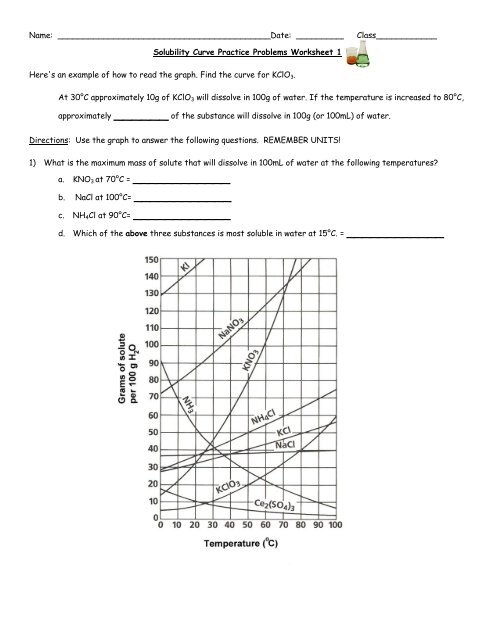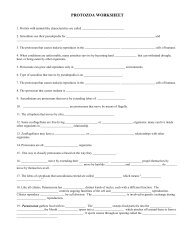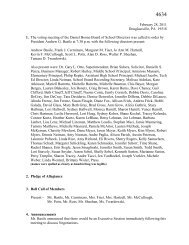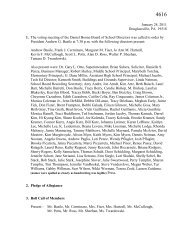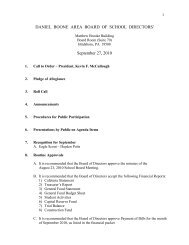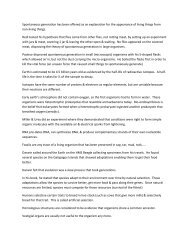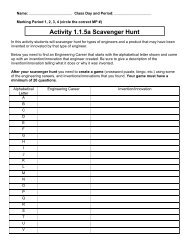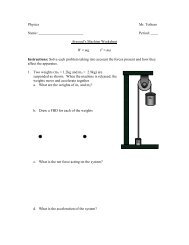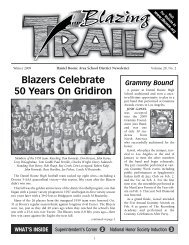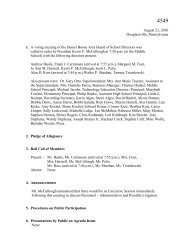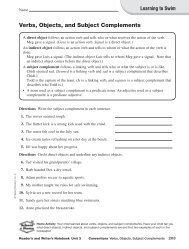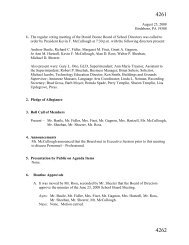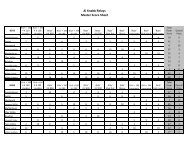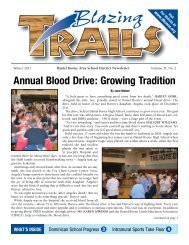Solubility Curve Practice Problems Worksheet 1
Solubility Curve Practice Problems Worksheet 1
Solubility Curve Practice Problems Worksheet 1
You also want an ePaper? Increase the reach of your titles
YUMPU automatically turns print PDFs into web optimized ePapers that Google loves.
Name: __________________________________________Date: ____________Class____________<br />
<strong>Solubility</strong> <strong>Curve</strong> <strong>Practice</strong> <strong>Problems</strong> <strong>Worksheet</strong> 1<br />
Here's an example of how to read the graph. Find the curve for KClO 3 .<br />
At 30°C approximately 10g of KClO 3 will dissolve in 100g of water. If the temperature is increased to 80°C,<br />
approximately ______ of the substance will dissolve in 100g (or 100mL) of water.<br />
Directions: Use the graph to answer the following questions. REMEMBER UNITS!<br />
1) What is the maximum mass of solute that will dissolve in 100mL of water at the following temperatures?<br />
a. KNO 3 at 70°C = ____________<br />
b. NaCl at 100°C= ____________<br />
c. NH 4 Cl at 90°C= ____________<br />
d. Which of the above three substances is most soluble in water at 15°C. = ____________
2) Types of Solutions<br />
On a solubility curve, the lines indicate the concentration of a __________________ solution - the<br />
maximum amount of solute that will dissolve at that specific temperature.<br />
Values on the graph ____________ a curve represent unsaturated solutions - more solute could be dissolved<br />
at that temperature.<br />
Label the following solutions as saturated or unsaturated. If unsaturated, write how much more solute can be<br />
dissolved in the solution.<br />
Solution Saturated or Unsaturated? If unsaturated: How much<br />
more solute can dissolve in the<br />
solution?<br />
a solution that contains 70g of<br />
NaNO 3 at 30°C (in 100 mL H 2 O)<br />
a solution that contains 50g of NH 4 Cl<br />
at 50°C (in 100 mL H 2 O)<br />
a solution that contains 20g of KClO 3<br />
at 50°C (in 100 mL H 2 O)<br />
a solution that contains 70g of KI at<br />
0°C (in 100 mL H 2 O)<br />
Homework – Use the <strong>Solubility</strong> Graphs on Page 1<br />
1. a. What is the solubility of KCl at 5 C? _______<br />
b. What is the solubility of KCl at 25 C? _______<br />
c. What is the solubility of Ce 2 (SO 4 ) 3 at 10 C? _______<br />
d. What is the solubility of Ce 2 (SO 4 ) 3 at 50 C? _______<br />
2. a. At 90 C, you dissolved 10 g of KCl in 100. g of water. Is this solution saturated or unsaturated?<br />
b. How do you know?<br />
3. A mass of 100 g of NaNO 3 is dissolved in 100 g of water at 80ºC.<br />
a) Is the solution saturated or unsaturated?______________________________<br />
b) As the solution is cooled, at what temperature should solid first appear in the solution? Explain.<br />
4. Use the graph to answer the following two questions:<br />
Which compound is most soluble at 20 ºC? ________
Which is the least soluble at 40 ºC? ________<br />
5. Which substance on the graph is least soluble at 10 C? __________<br />
6. A mass of 80 g of KNO 3 is dissolved in 100 g of water at 50 ºC. The solution is heated to 70ºC. How many more<br />
grams of potassium nitrate must be added to make the solution saturated? Explain your reasoning (See question<br />
#2 on the other side for a hint)<br />
7. Elements review: Fill in the chart below for some of the compounds on the graph:<br />
Formula Formula Mass If the following amounts of solute are dissolved in 100 mL of<br />
water: Is the solution SATURATED OR UNSATURATED<br />
Example: NaCl Na = 22.99<br />
3 grams dissolved at 0ºC<br />
Cl = 35.45<br />
58.44g/mol<br />
Formula Formula Mass If the following amounts of solute are dissolved in 100 mL of<br />
water: Is the solution SATURATED OR UNSATURATED<br />
120 grams dissolved at 0ºC<br />
KI<br />
Ce(SO 4 ) 3<br />
7.2 grams dissolved at 70ºC<br />
11 grams dissolved at 46.7ºC<br />
NH 4 Cl


